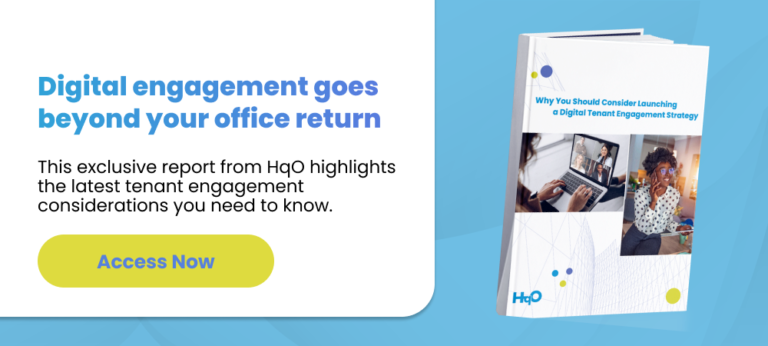With an increased emphasis on workplace experience taking hold of commercial real estate (CRE), the need for young talent in the workforce has become paramount to the industry’s success. In 2019, the United States Bureau of Labor Statistics reported that the median age of professionals working in real estate was 48.3, and the median age employed in commercial real estate was 42.9. As the median age increases, the industry continues to struggle attracting younger hires, as publications such as Bisnow point out.
Why is this age gap so important? Today, millennials already make up 50% of the labor pool, and by 2025, they are projected to reach a staggering 75% of the global workforce. In the same way that CRE as a whole has been slow to adopt new technology, the industry has not yet fully modernized their employee experience through internal technology tools. Thus, antiquated office experiences and skill sets are no longer representative of the younger generations they need to engage with. Without establishing a modern employee experience model, CRE won’t be able to access the digital native generation — or their tech-savvy skill sets that will bring the industry forward.
What is it about digital natives that makes them so essential?
Despite the clear-cut data in the modern workforce will become younger and younger by the year, there are a few key qualities that digital natives have that make them essential to the modern workplace experience.
- Their “information-age mindset”: technology is one of the most overt factors that define this new wave of workers, and it is not going anywhere. This is especially the case for commercial real estate: Deloitte’s CRE Outlook tells us that 92% of owners plan to maintain or increase their tenant experience-related technology investments over the next year. Gen Z behaviors are indicative of the “information-age mindset,” which describes the difference between those individuals who did and did not grow up with technology. In fact, Gen Zers are the first digital natives; they don’t know what life was like before the Internet.
- Millennials, on the other hand, also had a unique upbringing: while technology may not have defined their childhood, they certainly are not able to live without it today. This group of workers remember a time when smartphones and tablets didn’t exist, but they cannot imagine life without these tools now.
- The role of technology in their day-to-day life: even before the pandemic, for Millennials and Gen Zers, a typical morning may have included waking up via cell phone alarm, listening to a podcast on the morning commute, and ordering a ride-share service to the office. On a busy day, a positive experience at work may have also included easily ordering ahead for food delivery or pick-up — from services such as UberEats or Grubhub — to their office.
How do these unique qualities relate to workplace experience?
There are several key ways in which Millennial and Gen Z lives differ from the older generations present in the workforce. However, it’s clear that the implications of these differences extend far beyond social media, Netflix, and avocado toast –they have found their way into the modern workplace.
- Much to the chagrin of those that claim Millennials are “lazy” and “disengaged,” studies have shown that the use of social media has actually advanced the collaboration skills of this generation. This younger generation has been able to aptly transfer their collaborative social media skills into the modern-day workplace as the use of programs such as Zoom, Slack, and Microsoft Teams has become essential throughout the pandemic.
- The average Millennial thrives in a “supportive and nurturing environment that promotes teamwork,” solidifying the importance of digital engagement strategies, and ways to collaborate safely in the office (when the time comes).
- Studies have also shown that because this new generation desires meaningfulness in their relationships and work, an employee experience model that can bridge the physical and digital aspects of a workplace to foster workplace culture is crucial for an organization that wants to gain and keep employees of value.
Undoubtedly, technology has created and now fuels the largest segment of workers — meaning that it is in the older generation’s best interest to apply renewed effort into workplace experience initiatives if they want to sustain their workforce. As this Future Offices report candidly states: “If employees don’t have access to the technology they need, all other office experience investments will be for naught.”
What does this technology look like for CRE today?
In order to meet the increasingly dynamic needs of today’s workforce, CRE must facilitate an employee experience model fueled by modern technology. In 2021, “phygital” experiences, or the use of technology to bridge the divide between the physical and digital worlds in a unique and interactive way for the end-user, will be tantamount to a positive experience at work due to their unique abilities to connect people to each other and the workplace, no matter where they work.
In the same vein, fostering “phygital” or omnichannel office experiences are especially crucial for CRE professionals looking to attract younger talent. In doing so, they will provide integrated experiences that allow building occupants to seamlessly transition between digital and physical offerings. But how? Keeping up with evolving tenant needs and creating successful, adaptable “phygital” offerings for any portfolio begins with the tenant experience.
Through an end-to-end operating system for tenant experience such as HqOS, CRE teams can:
- Reduce environmental impact: install lighting and temperature control features that can adapt to your tenants’ needs throughout the day.
- Incorporate digital programming: more virtual initiatives will help building communities foster a vibrant, tech-enabled workplace culture.
- Ensure that the tenant’s office journey is safe and frictionless: implement mobile access technologies and touchless entrance sensors.
- Leverage technology partners: offer tenants both virtual and in-person activities, such as fitness and wellness classes.
- Provide tenants with more peace of mind: increase your building’s cleaning and sanitation protocols.
Embracing the tech-related demands of Millennials and Gen Zers, sooner rather than later, also applies to a post-pandemic workforce.
As HqO CEO and co-founder Chase Garbarino points to in our 2021 report on the industry, it is time for CRE to start the change management process to attract younger, more tech-savvy talent, and to bring the new generation and skillset in-house. The industry also needs to start providing more tech-enabled experiences, and these two things will combine real data with talent in order to maintain long-term commitment from customers.
To truly provide a positive experience at work, it’s critical to understand that the new generations prioritize experiences over “stuff.” Equipped with a tenant engagement program that blends physical and digital experiences, you can become a workplace experience expert. This will not only improve your engagement with modern workers, but increase the value of your assets substantially. You’ll soon see: adhering to the new standards of workplace excellence is invaluable, and will generate short- and long-term success for your entire portfolio.
Learn more about HqO’s digital engagement strategies in our employee experience case study, and find out how our partner technologies can work together to help you increase tenant satisfaction by scheduling a demo today.




